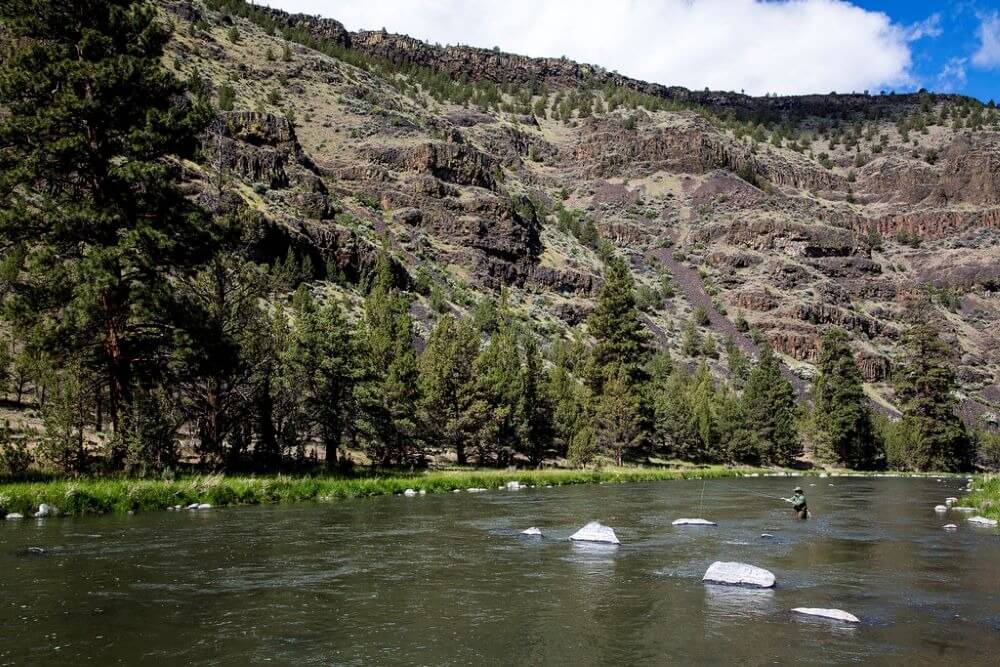
Fish Are Under Increased Pressure; What Can You Do To Improve Survival?
The good news is that interest in fly-fishing is increasing due in part to the pandemic and people wanting to get outdoors more in a socially distanced way, the increase in women and youth interest in the sport and changing cultural and work environments that give people more time to fish. The bad news is that the increased pressure is having a detrimental impact on fisheries and fish survival. An example is the Big Hole River in Montana where the number of annual angler days has more than doubled since 2008. At the same time there has been a precipitous drop in fish counts per mile to around 400. Biologists are also seeing a decline in mature year-class fish.
If you spent any time on the Deschutes or Crooked Rivers this year, you may have noticed the tremendous increase in anglers. A friend fished the Crooked recently and reported that he had to bring his own rock to fish from! I went into the fly shop in Maupin during the Salmon Fly hatch, and they had already had over 200 customers and it was only early afternoon.
What can we do while fishing to help our fisheries survive not just angler pressure, but increased water temperatures, habitat degradation, dams, irrigation and all the other pressures on the fish? This is not to say it isn’t OK to keep the occasional fish for the frying pan or BBQ. In fact, in some ways, taking a few of the small fish to eat can help others survive and thrive.
Here are some of the things you can to as you fish to help survival rates –
- Practice catch and release, but do it right!
- Use single point hooks. Treble hooks or the double hooks that used to be popular for half-pounders on the Rogue, can do extensive damage to the gills of fish causing bleeding and are much harder to remove.
- Use barbless hooks. This one can be a bit debatable as there are those who believe that barbless hooks penetrate better thus doing more damage to the fish through deeper hook-ups. I believe it is much easier to release fish with barbless hooks and the much lower time it takes to do so is better for the fish.
- If you cannot see the fly easily in the fishes’ mouth, don’t try to remove it, cut it off. The fly will degrade in just a few days or the fish may be able to rub it away on river structure.
- Use a net, and preferably one with rubber mesh. Nylon mesh, like the old ones with knots, damage fins and can rub the protective slime off the fish. This exposes them to fungus and diseases. Nets also allow for a shorter fight which keeps the fish from totally wearing out and creating fatal levels of lactic acid in the blood.
- Don’t use gloves – they can also remove slime. I have noticed when I use sun protection gloves, they really smell fishy after a release. I did not realize what damage I was causing. Back to the ole sunscreen…
- Use a fish release tool. This allows removal of the hook without touching the fish. I have used these on the Grand Ronde and the Deschutes, especially on small fish and they really work! Just remember to use it close to the water so the fish does not drop from too great a height. That could do damage too!
- Carry a thermometer and use it – especially for salmonids and most trout. If the temperature approaches 70 degrees, stop fishing! This year especially, the fear is growing that high water temps and the resultant fish kills could be extensive. The temperature at the mouth of the Deschutes was already in the high sixties last month! This might be the year to explore bass, carp, blue gill and other “warm water” species.
- Keep ‘em wet! It is nice to take pictures to show friends and have memories. But, as one friend says, how many fish pictures do you really need? If you do catch the trophy you want to record, keep the nose of the fish in the water. Even a few seconds out of the water can be life or death depending on circumstances. Visit keepfishwet.org for more information.
- Define in your own mind the definition of a great day! How many fish do you need to catch? Statistics suggest that at least 10% of catch and release fish will die, even if they swim away strongly.
I once saw a ‘T’ shirt that said – To catch a fish – To catch a big fish – To catch a lot of fish – To catch the uncatchable fish. That defines the evolution of a fisherman. I have added – To enjoy the fish’s environment, and To help the fish survive while enjoying the experience.
We can all make a difference. If we save just 1% more fish, that can result in thousands of healthy fish still in the water.
Rick Pay
